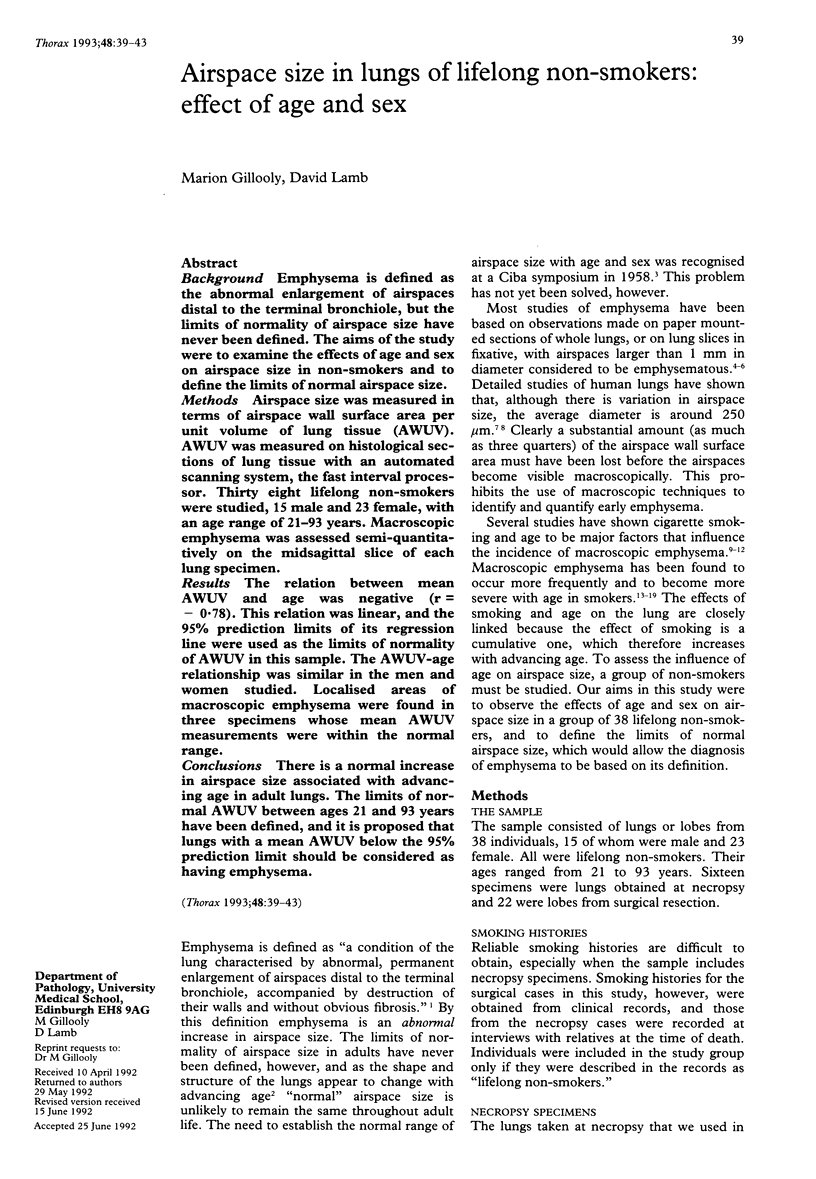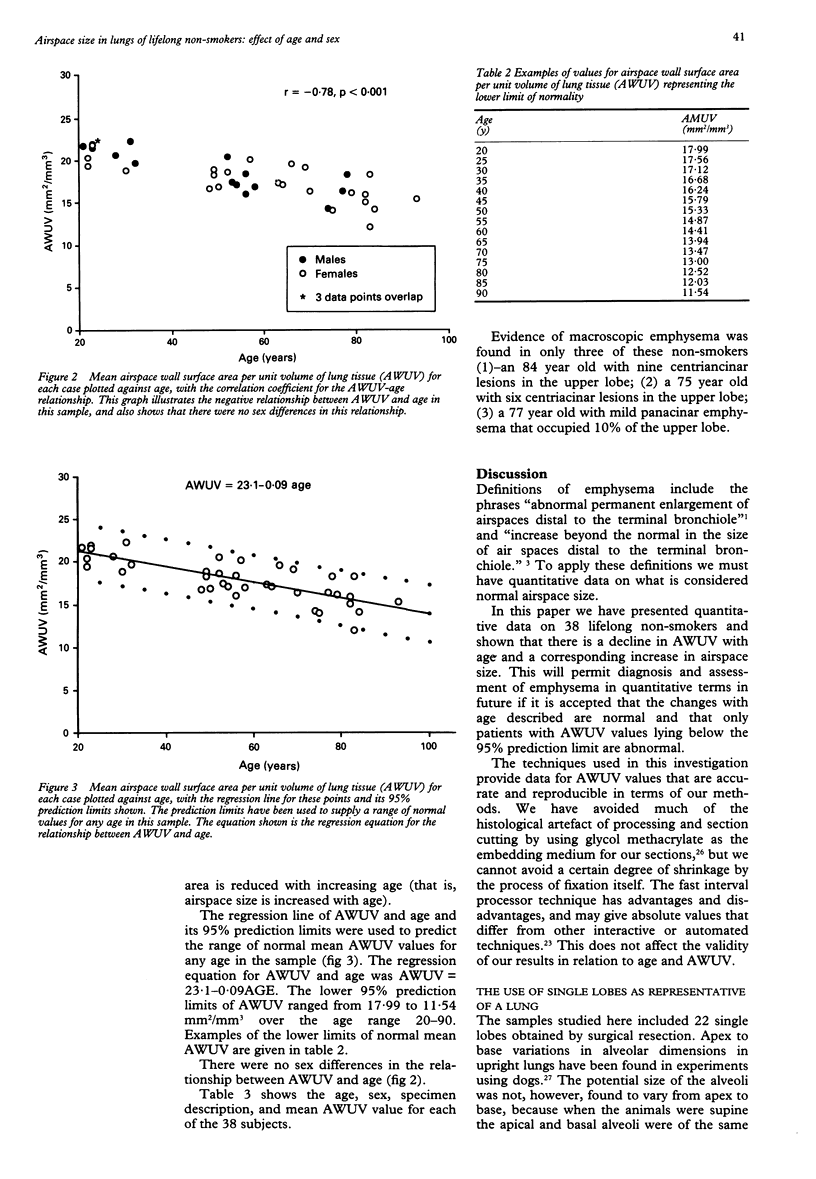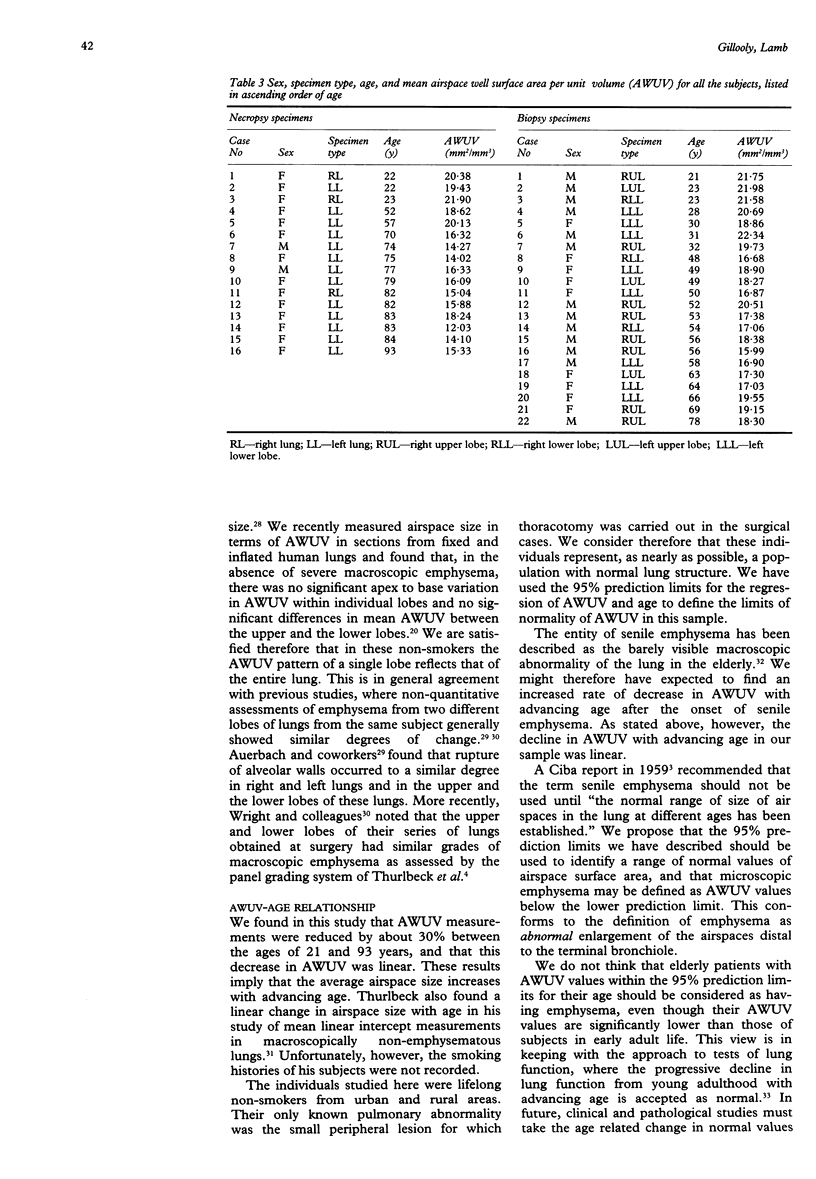Abstract
BACKGROUND: Emphysema is defined as the abnormal enlargement of airspaces distal to the terminal bronchiole, but the limits of normality of airspace size have never been defined. The aims of the study were to examine the effects of age and sex on airspace size in non-smokers and to define the limits of normal airspace size. METHODS: Airspace size was measured in terms of airspace wall surface area per unit volume of lung tissue (AWUV). AWUV was measured on histological sections of lung tissue with an automated scanning system, the fast interval processor. Thirty eight lifelong non-smokers were studied, 15 male and 23 female, with an age range of 21-93 years. Macroscopic emphysema was assessed semi-quantitatively on the midsagittal slice of each lung specimen. RESULTS: The relation between mean AWUV and age was negative (r = -0.78). This relation was linear, and the 95% prediction limits of its regression line were used as the limits of normality of AWUV in this sample. The AWUV-age relationship was similar in the men and women studied. Localised areas of macroscopic emphysema were found in three specimens whose mean AWUV measurements were within the normal range. CONCLUSIONS: There is a normal increase in airspace size associated with advancing age in adult lungs. The limits of normal AWUV between ages 21 and 93 years have been defined, and it is proposed that lungs with a mean AWUV below the 95% prediction limit should be considered as having emphysema.
Full text
PDF




Selected References
These references are in PubMed. This may not be the complete list of references from this article.
- ANDERSON W. F., ANDERSON A. E., Jr, HERNANDEZ J. A., FORAKER A. G. TOPOGRAPHY OF AGING AND EMPHYSEMATOUS LUNGS. Am Rev Respir Dis. 1964 Sep;90:411–423. doi: 10.1164/arrd.1964.90.3.411. [DOI] [PubMed] [Google Scholar]
- AUERBACH O., STOUT A. P., HAMMOND E. C., GARFINKEL L. SMOKING HABITS AND AGE IN RELATION TO PULMONARY CHANGES. RUPTURE OF ALVEOLAR SEPTUMS, FIBROSIS AND THICKENING OF WALLS OF SMALL ARTERIES AND ARTERIOLES. N Engl J Med. 1963 Nov 14;269:1045–1054. doi: 10.1056/NEJM196311142692001. [DOI] [PubMed] [Google Scholar]
- AZCUY A., ANDERSON A. E., FORAKER A. G. The morphological spectrum of aging and emphysematous lungs. Ann Intern Med. 1962 Jul;57:1–17. doi: 10.7326/0003-4819-57-1-1. [DOI] [PubMed] [Google Scholar]
- Adesina A. M., Vallyathan V., McQuillen E. N., Weaver S. O., Craighead J. E. Bronchiolar inflammation and fibrosis associated with smoking. A morphologic cross-sectional population analysis. Am Rev Respir Dis. 1991 Jan;143(1):144–149. doi: 10.1164/ajrccm/143.1.144. [DOI] [PubMed] [Google Scholar]
- Anderson A. E., Jr, Hernandez J. A., Holmes W. L., Foraker A. G. Pulmonary emphysema. Prevalence, severity, and anatomical patterns in macrosections, with respect to smoking habits. Arch Environ Health. 1966 May;12(5):569–577. doi: 10.1080/00039896.1966.10664435. [DOI] [PubMed] [Google Scholar]
- Anderson J. A., Dunnill M. S., Ryder R. C. Dependence of the incidence of emphysema on smoking history, age, and sex. Thorax. 1972 Sep;27(5):547–551. doi: 10.1136/thx.27.5.547. [DOI] [PMC free article] [PubMed] [Google Scholar]
- Auerbach O., Garfinkel L., Hammond E. C. Relation of smoking and age to findings in lung parenchyma: a microscopic study. Chest. 1974 Jan;65(1):29–35. doi: 10.1378/chest.65.1.29. [DOI] [PubMed] [Google Scholar]
- Gillooly M., Lamb D., Farrow A. S. New automated technique for assessing emphysema on histological sections. J Clin Pathol. 1991 Dec;44(12):1007–1011. doi: 10.1136/jcp.44.12.1007. [DOI] [PMC free article] [PubMed] [Google Scholar]
- Glazier J. B., Hughes J. M., Maloney J. E., West J. B. Vertical gradient of alveolar size in lungs of dogs frozen intact. J Appl Physiol. 1967 Nov;23(5):694–705. doi: 10.1152/jappl.1967.23.5.694. [DOI] [PubMed] [Google Scholar]
- Gould G. A., MacNee W., McLean A., Warren P. M., Redpath A., Best J. J., Lamb D., Flenley D. C. CT measurements of lung density in life can quantitate distal airspace enlargement--an essential defining feature of human emphysema. Am Rev Respir Dis. 1988 Feb;137(2):380–392. doi: 10.1164/ajrccm/137.2.380. [DOI] [PubMed] [Google Scholar]
- Lamb D., Gillooly M., Farrow A. S. Microscopic emphysema and its variations with age, smoking, and site within the lungs. Ann N Y Acad Sci. 1991;624:339–340. doi: 10.1111/j.1749-6632.1991.tb17040.x. [DOI] [PubMed] [Google Scholar]
- Ryder R. C., Dunnill M. S., Anderson J. A. A quantitative study of bronchial mucous gland volume, emphysema and smoking in a necropsy population. J Pathol. 1971 May;104(1):59–71. doi: 10.1002/path.1711040108. [DOI] [PubMed] [Google Scholar]
- Ryder R. C., Thurlbeck WM GOUGH J. A study of interobserver variation in the assessment of the amount of pulmonary emphysema in paper-mounted whole lung sections. Am Rev Respir Dis. 1969 Mar;99(3):354–364. doi: 10.1164/arrd.1969.99.3.354. [DOI] [PubMed] [Google Scholar]
- Schreider J. P., Raabe O. G. Structure of the human respiratory acinus. Am J Anat. 1981 Nov;162(3):221–232. doi: 10.1002/aja.1001620304. [DOI] [PubMed] [Google Scholar]
- Snider G. L. Chronic obstructive pulmonary disease: risk factors, pathophysiology and pathogenesis. Annu Rev Med. 1989;40:411–429. doi: 10.1146/annurev.me.40.020189.002211. [DOI] [PubMed] [Google Scholar]
- Sobonya R. E., Burrows B. The epidemiology of emphysema. Clin Chest Med. 1983 Sep;4(3):351–358. [PubMed] [Google Scholar]
- Spain D. M., Siegel H., Bradess V. A. Emphysema in apparently healthy adults. Smoking, age, and sex. JAMA. 1973 Apr 16;224(3):322–325. [PubMed] [Google Scholar]
- Sutinen S., Vaajalahti P., Päkkö P. Prevalence, severity, and types of pulmonary emphysema in a population of deaths in a Finnish city. Correlation with age, sex and smoking. Scand J Respir Dis. 1978 Apr;59(2):101–115. [PubMed] [Google Scholar]
- The definition of emphysema. Report of a National Heart, Lung, and Blood Institute, Division of Lung Diseases workshop. Am Rev Respir Dis. 1985 Jul;132(1):182–185. doi: 10.1164/arrd.1985.132.1.182. [DOI] [PubMed] [Google Scholar]
- Thurlbeck W. M., Ryder R. C., Sternby N. A comparative study of the severity of emphysema in necropsy populations in three different countries. Am Rev Respir Dis. 1974 Feb;109(2):239–248. doi: 10.1164/arrd.1974.109.2.239. [DOI] [PubMed] [Google Scholar]
- Thurlbeck W. M. The internal surface area of nonemphysematous lungs. Am Rev Respir Dis. 1967 May;95(5):765–773. doi: 10.1164/arrd.1967.95.5.765. [DOI] [PubMed] [Google Scholar]
- West J. B. Distribution of mechanical stress in the lung, a possible factor in localisation of pulmonary disease. Lancet. 1971 Apr 24;1(7704):839–841. doi: 10.1016/s0140-6736(71)91501-7. [DOI] [PubMed] [Google Scholar]
- Wright J. L., Barry W., Paré P. D., Hogg J. C. Ranking the severity of emphysema on whole lung slices. Concordance of upper lobe, lower lobe, and entire lung ranks. Am Rev Respir Dis. 1986 May;133(5):930–931. [PubMed] [Google Scholar]


